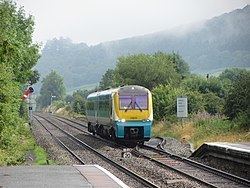Type Heavy Rail Line length 135,796 m Number of tracks Double track throughout | Operating speed | |
 | ||
Locale West Midlands (region)WalesHerefordshireShropshireCheshireNewportTorfaenMonmouthshireNorth West England Track gauge 4 ft 8 1⁄2 in (1,435 mm) standard gauge | ||
Manchester piccadilly train station
The Welsh Marches line (in Welsh: Llinell y Mers), known historically as the North and West Route, is the railway line running from Newport in south-east Wales to Shrewsbury in the West Midlands region of England by way of Abergavenny, Hereford and Craven Arms and thence (by some definitions) to Crewe via Whitchurch. The line thus links the south of Wales to north-west England via the Welsh Marches region, bypassing Birmingham. Through services from south-west Wales, Swansea and Cardiff to Manchester (hourly in each direction) and from Cardiff to Wrexham, Chester, the north coast of Wales and Anglesey (every two hours in each direction) constitute the bulk of passenger operations on the route.
Contents
Crewe train station
History
The line that exists today is the amalgamation of two lines, both with influence from the LNWR. The southern section from Newport to Hereford is formed from the Newport, Abergavenny and Hereford Railway, while the northern section from Hereford to Shrewsbury is formed from the joint GWR/LNWR Shrewsbury and Hereford Railway. From Shrewsbury north to Crewe, the line runs over the LNWR-owned Crewe and Shrewsbury Railway.
When the two railways arrived in the important market town of Hereford, the LNWR had already built Hereford Barton. The S&HR and the GWR agreed to build the Hereford Barrs Court, which was then also used by the Midland Railway's Hereford, Hay and Brecon Railway. After Hereford Council put pressure on the LNWR, they closed Hereford Barton to passengers, using it as a joint goods depot.
Under the 1960s Beeching Axe, many of the supporting branch lines were closed and the Hereford Barton loop closed. The remaining Hereford station was renamed Hereford Station and, to this day, retains its Victorian Gothic architecture.
Route
The cities, towns and villages served by the routes are listed below from south to north:
Services
Arriva Trains Wales operate all passenger services on the line. Typically, there is an hourly service from Manchester Piccadilly to Cardiff Central, Carmarthen, Milford Haven, calling at principal stations. A service every two hours from Holyhead to Cardiff also uses the Marches line from Shrewsbury southwards. Additionally, local stopping services operate between Crewe and Shrewsbury and services via the Heart of Wales line use the Marches line between Shrewsbury and Craven Arms.
The line is very popular for railtours, both steam and diesel. During Autumn 2007, 6201 'Princess Elizabeth' visited the route on two returns and one single run from Bristol to Shrewsbury and Crewe. A few railtours hauled by Class 37s and Class 47s also travelled along the line during the same time of year.
